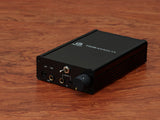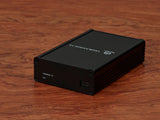TSURANAGI-V2 is a Version 2 model improved based on feedback obtained from TSURANAGI.
Noise level has been halved and improved to play more subtle sounds.
The three main changes are "6dB reduction in gain," "volume curve change," and "change to laser engraving.
The TSURANAGI portable amplifier was developed as an evaluation unit for the development of BriseAudio's high-end earphone cables and high-end portable line cables (mini-mini cables) in order to create an ideal portable audio environment. BriseAudio cables are used for internal wiring, and the electromagnetic wave absorbing shielding material and CNT (carbon nanotube) used in our high-end cables MURAKUMO and YATONO are installed on the board to further improve the sound quality.
Overview
- Portable amplifier with analog input and output for earphones and headphones
- Balanced input/output
- Balanced output for unbalanced input signals
- Pentaconn 4.4mm connector
- Input: balanced/unbalanced (5-pin 4.4mm + 3-pin 3.5mm)
- Output: symmetrical (5-pin 4.4 mm + 4-pin 2.5 mm)
- Equipped with high-quality electronic volume IC MUSES72320
- High input impedance and high common-mode noise rejection through low-noise differential line receiver
- Asymmetrical-symmetrical conversion through low-noise, fully differential operational amplifier
- Low-distortion current feedback amplifier for driving headphones
- Dual power supply and DC servo eliminate input and output coupling capacitors.
- Charging via USB Type C
- Continuous playback time of approximately 8 hours (depending on your environment)
product concept
In response to the recent increase in the number of playback devices with balanced LINE OUTs and balanced drive for headphones and earphones, Brise Audio has developed a portable amplifier with ideal balanced input/output for the development of mini-mini cables and re-cables .
To enable connection to conventional playback devices, an unbalanced 3-pin 3.5 mm input is also available, which is internally converted into a high-precision balanced signal before being output.
Both 5-pin 4.4mm and 4-pin 2.5mm connectors are available for outputs. The design is based on low distortion and low noise, with the aim of reproducing all the information from the source.
Low performance of any of the circuits, from input to output, will result in poor overall performance, so low distortion and low noise circuits and components are used in all signal processing circuits.
The high input impedance of 1 MΩ also minimizes distortion at the output of the upstream player.
A differential line receiver precisely converts the balanced signal into an unbalanced one to eliminate extraneous noise and ensure clean reproduction even in noisy outdoor areas.
The amplifier's central composite amplifier performs the conversion of unbalanced to balanced signals and the current amplification simultaneously.
Distortion is further reduced by integrating a current feedback amplifier into the feedback loop of all differential operational amplifiers.
The power supply circuit uses ultra-low noise and ultra-high PSRR regulators and supplies each channel independently.
A six-layer board is used to eliminate common impedance and improve signal quality in terms of layout.
As with the development of our cables, TSURANAGI pays attention to high sound performance, a wide bandwidth, no sound distortion and a low noise floor.
In addition, we design our cables with the goal of minimizing the impact of the external environment and getting as much performance out of the equipment as possible, both in terms of sound quality and performance.
TSURANAGI is a reference for our cable development environment, and we tried to develop an amplifier that does not affect the performance and sound quality of the cable. Cables are also designed not to become bottlenecks in the system, so we want to raise the bar even higher internally.
Innovations & Highlights
New amplifier features include an amplifier bandwidth of 2 Hz to 200 kHz to ensure flat reproduction in the audible range of 20 Hz to 20 kHz.
The differential DC servo amplifier detects the differential DC current of the balanced output and feeds it back to all differential operational amplifiers so that the offset is zero.
This reduces the DC offset of the output to +/-50 µV and eliminates the need for coupling capacitors on the input side. The OPAMPs used in the DC servo amplifiers are also extremely high-performance, low-noise products to ensure that sound quality is not compromised.
Should the unlikely event that a DC offset occurs, the integrated microcontroller detects this and protects the headphones.
All power supply decoupling capacitors in the signal processing circuits use film capacitors and conductive polymer aluminum capacitors.
To ensure sound quality, all components are carefully tested and used without regard to cost.










